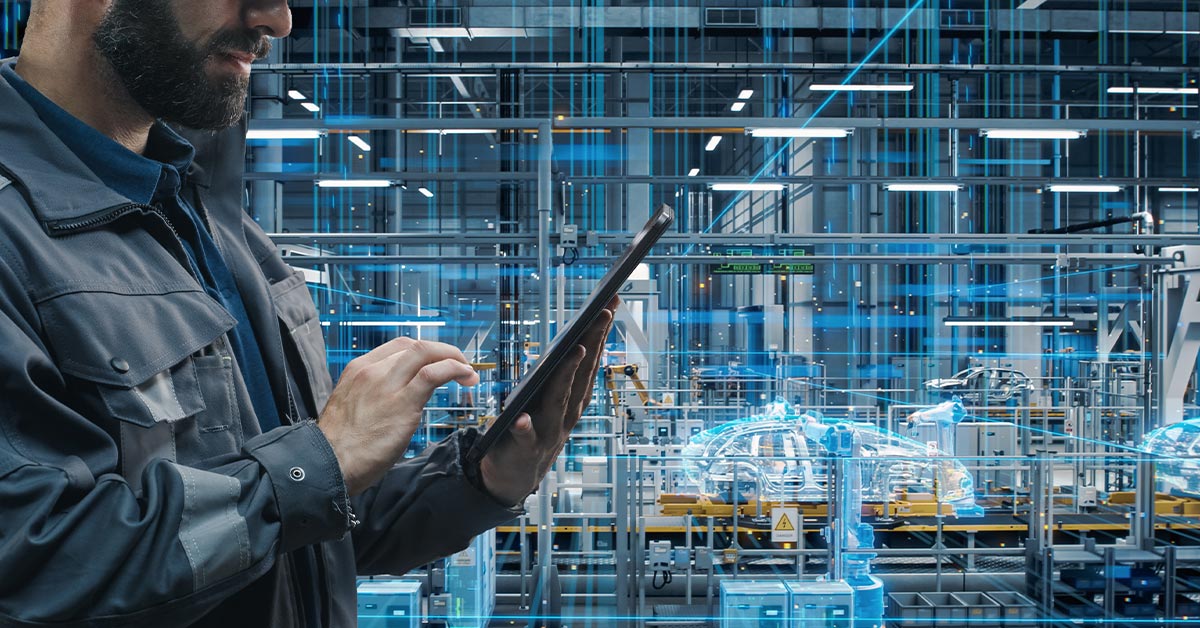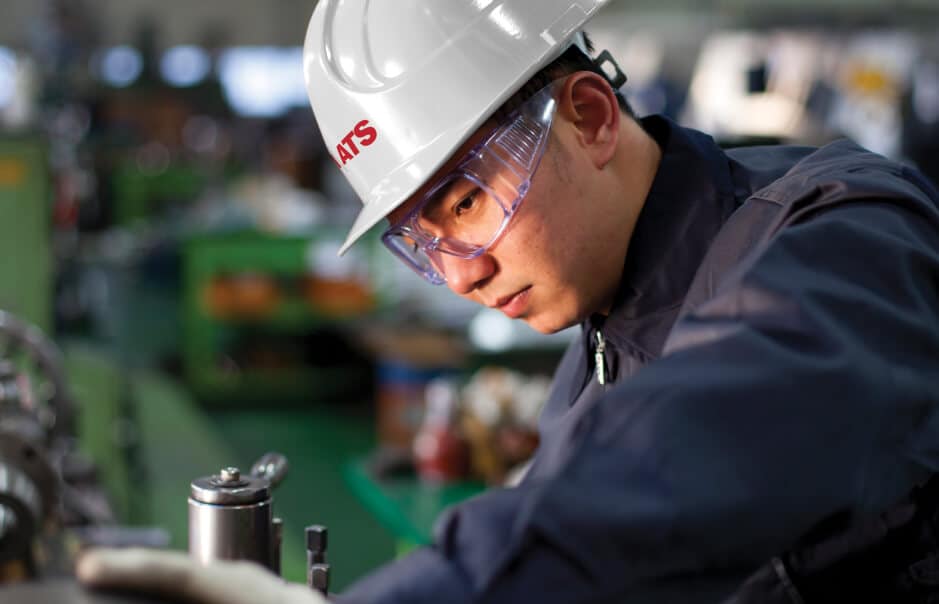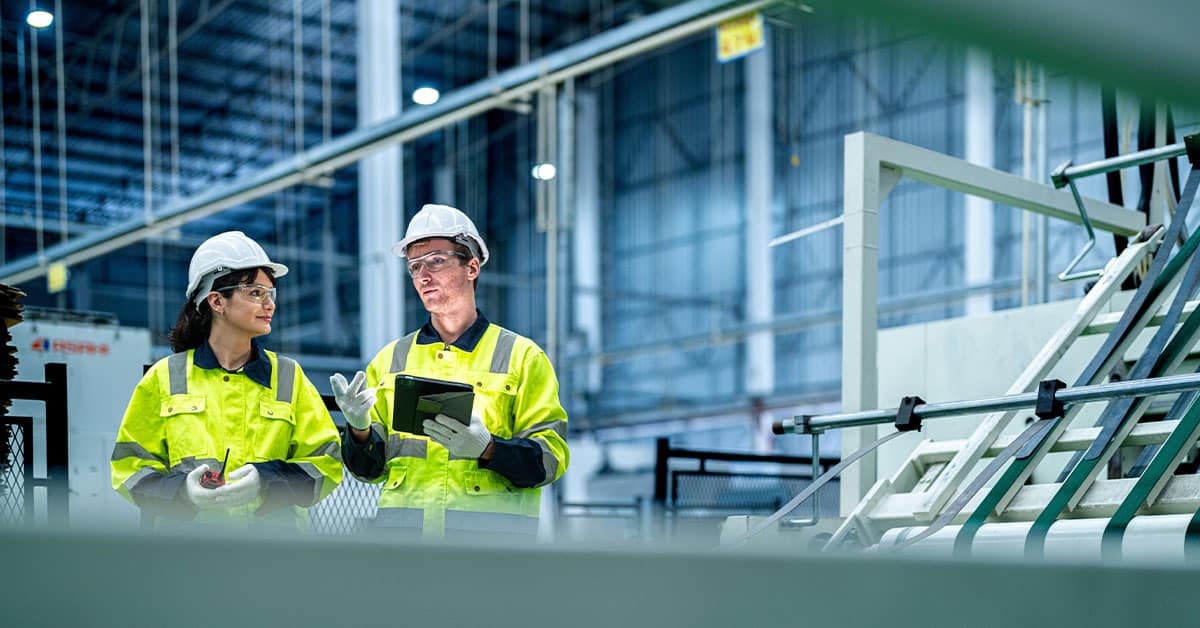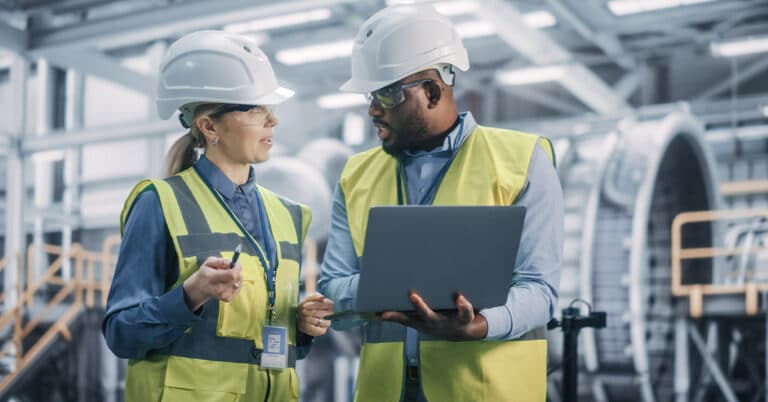What’s the manufacturing outlook for 2024? Despite some momentum in manufacturing after the downturns caused by the coronavirus pandemic, analysts are also now anticipating a period of economic uncertainty in the manufacturing industry in 2024, according to the latest survey covering the industrial sector outlook from Deloitte.
In terms of the industrial sector forecast for skilled labor availability, Deloitte noted that hourly earnings rose 4% on average between the first quarter of 2022 and 2023, while the number of voluntary separations declined 19% in this period.
Per Deloitte, approximately 86% of manufacturing executives responding to the latest industrial outlook survey indicate that in 2024, smart factory solutions will be one of the main competitive advantages supporting their endeavors for the next five years.
The following five factors are poised to potentially help manufacturers overcome potential challenges and be better positioned to address and adjust to negative factors. These factors will influence the industry, its processes and how infrastructure, investment and other key decisions are made. Read on to learn more about them.
Factors influencing the manufacturing industry outlook
These five factors have been identified as having the most potential to influence outcomes and results for manufacturers over the next several years.
Technology
Digital technology implementation remains a continued focus for the manufacturing industry, driven as much by ongoing innovation as it is by its identified ability to overcome uncertainties and challenges like those exposed by the pandemic. Technology implementation impacts the following aspects of manufacturing:
- Improved capabilities and capacity: Digital transformation in manufacturing has driven vast increases in automation capabilities, increasing productivity at a volume not seen in decades. AI and machine learning are also helping to improve manufacturing quality and efficiency through advances in automation, collaboration, innovation and other areas. Vision systems, smart manufacturing and technology such as connected industrial sensors are all driving significant increases in manufacturing performance, productivity and output
- Scalability and long-term profitability: By investing in digital technology now, manufacturers are positioning themselves for easier and more streamlined scalability, creating the foundation of the infrastructure that will likely support them through the next decade, and possibly longer. Technology is also helping manufacturers to lock in long-term profitability, especially as equipment and infrastructure investments pay back their costs and begin to show a return. The longer manufacturers wait to upgrade their technology, the further behind competitors and the market they will be.
- Continued digital investment: The promise of new industrial technology solutions in manufacturing is no longer an abstract concept: Manufacturers have clearly seen the benefits of technology investments, and are now continuing to invest in this aspect of their operations in order to stay ahead of the competition, improve flexibility and increase the positive results they are seeing in productivity, quality, efficiency and other areas.

According to a 2024 Deloitte survey, the top technology adoptions for manufacturers are:
- Generative AI
- Product decarbonization
- Electronic vehicles
- New verticals for zero-emission products
- Blockchain
- Robotics and automation
- Data analytics
- IIoT platform
- Additive manufacturing
- Cloud computing
- Artificial intelligence
- Advanced materials
- Digital twin
- 5G connectivity
- Augmented/virtual reality
- Edge computing
Supply chain
Supply chain issues have been among the longest lingering after-effects of the pandemic, with reliability and consistency problems continuing to appear in logistics. The following aspects of supply chain management have been identified as potential strategies to help improve these areas.
- Relationship management: The reality of today’s ongoing supply chain issues means that supplier relationships can no longer be taken for granted or treated as commodities. Supplier and vendor relationship management can help manufacturers achieve more favorable results more often and can be a valuable tool in supplier assessments and reviews, helping to create more productive working partnerships.
- Increased local capacity: This concept is also called “reshoring,” and refers to manufacturers opening and sourcing from facilities in the U.S., as opposed to relying primarily or entirely on international suppliers for production materials, OEM parts, equipment, components and other products. The root of many supply chain issues comes down simply to the distances that materials must travel, and the various complications that may occur due to this extensive distance and time, including weather, delays, macroeconomics and geopolitical obstacles, to name just a few. Bringing production closer to home may mean higher direct, upfront costs, but these can be offset by savings in delivery time, remediation time and effort, increased control over macro factors and increased quality.
- Adopting supply chain technology: Advances in manufacturing technology are tailor made to support improved supply chain efficiency and productivity. Examples of technology applications for the supply chain include MRO purchasing system digitization and automation, inventory and storeroom management systems, and supplier relationship systems. The key factor in applying supply chain management system technology is centralizing real-time and historical information, records, data and controls, which can then be used to identify issues and drive more effective decision-making in the short- and long-term. Supply chain technology can go hand-in-hand with the relationship management strategy described above, providing unparalleled insight into the productivity and effectiveness of current and potential supplier partnerships. In addition, supply chain and inventory technology can help to increase the efficiency and speed of maintenance processes through increased storeroom accuracy.
Skilled workforce
Difficulties in finding, attracting and keeping skilled workers has been a longstanding challenge for manufacturers, predating the pandemic and continuing through to today. While some advances have been made in communicating the advantages of newly available manufacturing jobs, in contrast to the traditional conceptions of the industry, many obstacles still remain in the pursuit of a robust, sustainable workforce as long-tenured workers continue to retire and take with them invaluable knowledge and experience. The following approaches have been identified as effective ways to attract more employees and improve retention.
- Wage increases: Higher wages for skilled technicians are increasingly viable thanks to the support of automation and other technology, much of which is described in this article. While manufacturing positions have frequently offered competitive wages, recent history shows that this was not enough to attract a younger generation of employees. Higher starting wages, along with more compelling raises and retention packages, are a relatively straightforward but effective way of bridging the skills gap.
- Upskilling and reskilling: As manufacturing technology changes, so do the needs and qualifications required for employees. Rather than expanding resources seeking out new hires, manufacturers can find the resources they need in-house by investing in training, upskilling and reskilling, helping their existing personnel to learn and adapt to the current face of the industry. Employees will often repay this investment with loyalty, becoming less likely to seek a job elsewhere and increasing their own value thanks to the institutional knowledge and expertise that they possess.
- Improving workplace culture: Workplace culture can be a nebulous concept and is one that is often neglected in manufacturing scenarios in the interest of productivity and the bottom line. Even offering a baseline of perks, however, can go a long way toward increasing employee morale and retention — which also has the effect of increased productivity.
- Diversity, equity and inclusion (DEI) initiatives: DEI initiatives can have a vast reach in improving the effectiveness, productivity and morale of a manufacturing workforce. By focusing on recruitment and support for demographics that have traditionally been underrepresented in manufacturing roles, manufacturers have an opportunity to reset and reframe workplace culture and make it better suited to the roles, responsibilities and technology driving improvements in manufacturing today.

ESG commitments
Corporate social responsibility is of increasing concern for businesses across every sector, and manufacturing is no exception. ESG is a critical concern for numerous reasons: compliance with increasingly common regulations, meeting investor expectations and fulfilling RFP requirements, to name just a few. In addition, ESG commitments can have the knock-on effect of improving overall facility cost-efficiency. ESG considerations include:
- Reducing pollution and waste: In the pursuit of reducing overall waste and pollution output, manufacturers can often identify more efficient processes and practices, such as reclamation and reuse of material that would otherwise be discarded. Organizations may also focus on more sustainable processes such as those which minimize waste, use recyclable and reusable materials, and enable easier reclamation.
- Supplier diversity: In a tumultuous time for the manufacturing industry and the economy at large, embracing change can be one of the most effective ways to weather uncertainty. Pursuing increased diversity in supplier choice can open up options that organizations may not have previously considered, and which will often prove to be fruitful and successful.
- Energy transformation: The shortcomings — and benefits — of traditional energy sources are well-known. The outlook for industries such as manufacturing in the mid- to long-term will almost certainly focus on more sustainable energy sources, which — like many technology advances — will likely require a significant upfront investment that will provide a positive return over time. Manufacturers can get a head start on this ROI — and any potential regulatory changes — by investigating and implementing green manufacturing and sustainable energy policies now.
Smart factories and industry 5.0
Beyond the strategies outlined above, manufacturers must continue to stay abreast of advances in manufacturing practices and technology. While much of the focus is on Industry 4.0 and the connected factory, the next step — Industry 5.0 and the truly smart factory — is already imminent. The good news is that Industry 5.0 builds on many of the technologies implemented for industry 4.0, and focuses on full integration across all production, analysis and maintenance processes. Industry 5.0 considerations include:
- Improved connectivity through the cloud, edge computing and 5G: Whereas Industry 4.0 introduced the connected facility and centralized data monitoring and analysis through sensors and Wi-Fi, Industry 5.0 draws on increased communication bandwidth and analytical power to enable even more effective and efficient decision making at the point of data collection.
- Disruptive technologies including augmented reality (AR), artificial intelligence (AI), Internet of Things (IoT), additive manufacturing, blockchain and advanced analytics: These technologies — many of which are implemented to some degree as part of Industry 4.0 — are poised for even greater breakthroughs by enabling collaboration and innovation from anywhere, improving maintenance efficiency by providing “hands-on” remote expertise through AR, and leveraging ever-improving 3D printing for production-quality parts.
- Cybersecurity in manufacturing: With increased connectivity comes increased risk for hackers and other nefarious actors to access manufacturing systems. As manufacturers enjoy the benefits of technology, they must also be vigilant against these risks.
Industrial market outlook
Analysts anticipate a number of rising industrial sector trends that will impact how companies manufacture items and develop the necessary skilled workforce to meet new demand, such as:
- Reshoring: Keeping manufacturing processes in the United States and bringing manufacturing jobs back for the domestic market are seen as key processes to attract skilled labor as well as encourage workers to build their skills in light of new opportunities here.
- Sustainability: Clean energy solutions in the form of environmentally sustainable vehicles, such as EVs (such as cars, delivery vans and forklifts) are making their way into the sustainability efforts of manufacturers, noted Deloitte. Its 2024 survey cited the case of a prominent engine manufacturer revamping its facilities in the U.S. to power engines with hydrogen, a low-carbon fuel that meets new clean energy efforts.
- Changing Workforce Landscape: According to Deloitte, about 46.8% of manufacturing executives responding to a NAM survey said they now offer more flexible scheduling to their production workers, in a bid to retain talented employees. When feasible, companies also offer remote work opportunities and will let workers split shifts or trade shifts with their colleagues. The traditional 9-5 schedule is giving way to compressed workweeks.
- Semiconductor and EV Manufacturing: Because of the ongoing supply chain disruptions stemming from the COVID shutdowns across the world, there are calls for manufacturers to construct their own chip fabrication facilities, as part of returning vital production processes to our shores. In keeping with the need to bring emissions to “net zero,” you can anticipate an uptick in manufacturing electric vehicles, for transporting workers as well as hauling goods without contributing to pollution.
With this understanding of the latest trends in manufacturing, you are aware of the changes to processes, practices and policies that will help your organization remain relevant and competitive. Let ATS help you implement and execute, contact us today.


